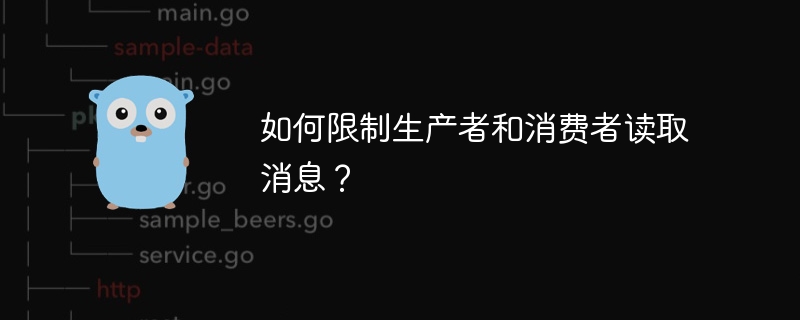如何限制生產者和消費者讀取訊息?
- WBOYWBOYWBOYWBOYWBOYWBOYWBOYWBOYWBOYWBOYWBOYWBOYWB轉載
- 2024-02-11 18:00:11993瀏覽

php小編子墨在軟體開發過程中,訊息佇列是一種常見的通訊機制,用於實現生產者和消費者之間的非同步通訊。然而,有時我們希望控制生產者和消費者對訊息的讀取,以便更好地管理系統資源和處理高峰時段的請求。本文將介紹一些限制生產者和消費者讀取訊息的方法,幫助開發者優化系統效能和提高應用的穩定性。
問題內容
我想用 go 獲得應用程式生產者-消費者(透過訊號關閉)。
生產者不斷在佇列中產生訊息,限制為 10 個。 一些消費者閱讀並處理該頻道。 如果佇列中的訊息數為0,生產者再次產生10個訊息。 當收到停止訊號時,生產者停止產生新訊息,消費者處理通道中的所有內容。
我找到了一段程式碼,但無法理解它是否正常工作,因為發現了奇怪的東西:
- 為什麼停止程式後,佇列中的消息並沒有全部處理完,好像遺失了部分資料。 (在螢幕截圖中,發送了 15 則訊息,但處理了 5 則訊息)
- 如何正確地將佇列限制為10個訊息,也就是必須寫入10個訊息,等待佇列計數器變成0時處理,然後再寫入10個訊息?
- 是否可以在停止訊號後通知生產者,以便他不再向通道產生新訊息? (在螢幕截圖中,生產者成功寫入佇列 - 12,13,14,15)
結果:
程式碼範例:
package main
import (
"context"
"fmt"
"math/rand"
"os"
"os/signal"
"sync"
"syscall"
"time"
)
func main() {
const nConsumers = 2
in := make(chan int, 10)
p := Producer{&in}
c := Consumer{&in, make(chan int, nConsumers)}
go p.Produce()
ctx, cancelFunc := context.WithCancel(context.Background())
go c.Consume(ctx)
wg := &sync.WaitGroup{}
wg.Add(nConsumers)
for i := 1; i <= nConsumers; i++ {
go c.Work(wg, i)
}
termChan := make(chan os.Signal, 1)
signal.Notify(termChan, syscall.SIGINT, syscall.SIGTERM)
<-termChan
cancelFunc()
wg.Wait()
}
type Consumer struct {
in *chan int
jobs chan int
}
func (c Consumer) Work(wg *sync.WaitGroup, i int) {
defer wg.Done()
for job := range c.jobs {
fmt.Printf("Worker #%d start job %d\n", i, job)
time.Sleep(time.Millisecond * time.Duration(3000+rand.Intn(3000)))
fmt.Printf("Worker #%d finish job %d\n", i, job)
}
fmt.Printf("Worker #%d interrupted\n", i)
}
func (c Consumer) Consume(ctx context.Context) {
for {
select {
case job := <-*c.in:
c.jobs <- job
case <-ctx.Done():
close(c.jobs)
fmt.Println("Consumer close channel")
return
}
}
}
type Producer struct {
in *chan int
}
func (p Producer) Produce() {
task := 1
for {
*p.in <- task
fmt.Printf("Send value %d\n", task)
task++
time.Sleep(time.Millisecond * 500)
}
}解決方法
為什麼停止程式後,佇列中的消息並沒有全部處理完,好像遺失了部分資料。
這是因為當ctx 完成後,(consumer).consume 停止從in 通道讀取,但go p.produce( ) 創建的goroutine 仍然寫入in 通道。
下面的演示解決了這個問題並簡化了原始程式碼。
註解:
-
produce在ctx完成後停止。並且它關閉了in通道。 -
欄位
jobs已從consumer中刪除,工作人員直接從in通道讀取。 -
以下要求被忽略,因為它很奇怪。常見的行為是,當作業產生時,如果
in通道未滿,則作業會立即發送到in通道;當它已滿時,發送操作將阻塞,直到從in通道讀取作業為止。如果佇列中的訊息數為0,生產者再次產生10個訊息
package main
import (
"context"
"fmt"
"math/rand"
"os/signal"
"sync"
"syscall"
"time"
)
func main() {
const nConsumers = 2
ctx, stop := signal.NotifyContext(context.Background(), syscall.SIGINT, syscall.SIGTERM)
defer stop()
in := make(chan int, 10)
p := Producer{in}
c := Consumer{in}
go p.Produce(ctx)
var wg sync.WaitGroup
wg.Add(nConsumers)
for i := 1; i <= nConsumers; i++ {
go c.Work(&wg, i)
}
<-ctx.Done()
fmt.Printf("\nGot end signal, waiting for %d jobs to finish\n", len(in))
wg.Wait()
}
type Consumer struct {
in chan int
}
func (c *Consumer) Work(wg *sync.WaitGroup, i int) {
defer wg.Done()
for job := range c.in {
fmt.Printf("Worker #%d start job %d\n", i, job)
time.Sleep(time.Millisecond * time.Duration(3000+rand.Intn(3000)))
fmt.Printf("Worker #%d finish job %d\n", i, job)
}
fmt.Printf("Worker #%d interrupted\n", i)
}
type Producer struct {
in chan int
}
func (p *Producer) Produce(ctx context.Context) {
task := 1
for {
select {
case p.in <- task:
fmt.Printf("Send value %d\n", task)
task++
time.Sleep(time.Millisecond * 500)
case <-ctx.Done():
close(p.in)
return
}
}
}
以上是如何限制生產者和消費者讀取訊息?的詳細內容。更多資訊請關注PHP中文網其他相關文章!
陳述:
本文轉載於:stackoverflow.com。如有侵權,請聯絡admin@php.cn刪除

